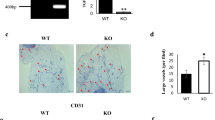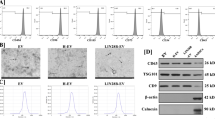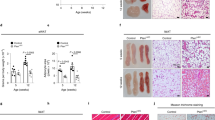Abstract
Objective:
Adipose tissue is closely associated with angiogenesis, but the mechanisms are not fully understood. Some of the adipocyte-derived cytokines are hypothesized to play an important role in angiogenesis. We evaluated tube formation of human umbilical vascular endothelial cells (HUVECs) cultured in type I collagen gel when overlaid with the supernatant of 3T3-L1 cell culture, and expression of tube-forming factor(s) in 3T3-L1 cells with or without pioglitazone. We also studied plasma growth factor levels in patients with type 2 diabetes mellitus treated with pioglitazone.
Results and methods:
The supernatant of 3T3-L1 cells increased tube formation of HUVECs by 9.03-fold of control. Reverse transcription-polymerase chain reaction showed that hepatocyte growth factor (HGF) and vascular endothelial growth factor (VEGF) mRNA were expressed in 3T3-L1 cells. Western blot analysis also demonstrated HGF and VEGF protein expression. When 3T3-L1 cells were treated with 100 nM small interfering RNAs (siRNAs) for HGF, the HGF mRNA and protein were suppressed. The VEGF mRNA and protein in the cells were also suppressed by siRNA for VEGF. The supernatant of 3T3-L1 cells treated with HGF siRNA suppressed tube formation of HUVECs by 61% compared with the supernatant of cells treated with control siRNA. Addition of VEGF siRNA resulted in no significant changes. The supernatant conditioned with pioglitazone further promoted the tube formation. Pioglitazone enhanced HGF mRNA expression in 3T3-L1 cells. After 12 weeks of pioglitazone treatment, the changes of plasma HGF levels in patients treated with pioglitazone were significantly higher than those in control.
Conclusion:
These results suggest that HGF secreted from 3T3-L1 cells may be the major factor regulating the tube formation, and agents that enhance the differentiation of adipocytes may promote tube formation of HUVECs mediated by HGF secreted by adipocytes.
This is a preview of subscription content, access via your institution
Access options
Subscribe to this journal
Receive 12 print issues and online access
$259.00 per year
only $21.58 per issue
Buy this article
- Purchase on Springer Link
- Instant access to full article PDF
Prices may be subject to local taxes which are calculated during checkout







Similar content being viewed by others
References
Folkman J . How is blood vessel growth regulated in normal and neoplastic tissue? G.H.A. Clowes memorial Award lecture. Cancer Res 1986; 46: 467–473.
Hausman GJ, Richardson LR . Histochemical and ultrastructural analysis of developing adipocytes in the fetal pig. Acta Anat 1982; 114: 228–247.
Crandall DL, Hausman GJ, Kral JG . A review of the microcirculation of adipose tissue: anatomic, metabolic, and angiogenic perspectives. Microcirculation 1997; 4: 211–232.
Coppack SW . Pro-inflammatory cytokines and adipose tissue. Proc Nutr Soc 2001; 60: 349–356.
Trayhurn P, Beattie JH . Physiological role of adipose tissue: white adipose tissue as an endocrine and secretary organ. Proc Nutr Soc 2001; 60: 329–339.
Hotamisligil GS, Shargill NS, Spiegelman BM . Adipose expression of tumor necrosis factor-alpha: direct role in obesity-linked insulin resistance. Science 1993; 259: 87–91.
Yamauchi T, Kamon J, Waki H, Murakami K, Motojima K, Komeda K et al. The mechanisms by which both heterozygous peroxisome proliferator-activated receptor gamma (PPAR gamma) deficiency and PPAR gamma agonist improve insulin resistance. J Biol Chem 2001; 276: 41245–41254.
Skurk T, Hauner H . Obesity and impaired fibrinolysis: role of adipose production of plasminogen activator inhibitor-1. Int Obes Relat Metab Disord 2004; 28: 1357–1364.
Caro J, Sinha M, Kolaczynski J, Zhang P, Considine R . Leptin: the tale of an obesity gene. Diabetes 1996; 45: 1445–1462.
Sharma A, Janke J, Gorzeliniak K, Engeli S, Luft C . Angiotensin blockade prevents type 2 diabetes by formation of fat cells. Hypertension 2002; 40: 609–622.
Gorzeliniak K, Engeli S, Janke J, Luft C, Sharma A . Hormonal regulation of the human adipose-tissue rennin–angiotensin system: relationship to obesity and hypertension. J Hypertens 2002; 20: 965–973.
Mick GJ, Wang X, McCormick K . White adipocyte vascular endothelial growth factor: regulation by insulin. Endocrinology 2002; 143: 948–953.
Nakagami H, Morishita R, Yamamoto K, Taniyama Y, Aoki M, Matsumoto K et al. Mitogenic and antiapoptotic actions of hepatocyte growth factor through ERK, STAT3, and AKT in endothelial cells. Hypertension 2001; 37: 581–586.
Morishita R, Sakaki M, Yamamoto K, Iguchi S, Aoki M, Yamasaki K et al. Impairment of collateral formation in lipoprotein(a) transgenic mice: therapeutic angiogenesis induced by human hepatocyte growth factor gene. Circulation 2002; 105: 1491–1496.
Hockel M, Schlenger K, Doctrow S, Kissel T, Vaupel P . Therapeutic angiogenesis. Arch Surg 1993; 128: 423–429.
Funatsu T, Sawa Y, Ohtake S, Takahashi T, Matsumiya G, Matsuura N et al. Therapeutic angiogenesis in the ischemic canine heart induced by myocardial injection of naked complementary DNA plasmid encoding hepatocyte growth factor. J Thorac Cardiovasc Surg 2002; 124: 1099–1105.
Shiota G, Umeki K, Okano J, Kawasaki H . Hepatocyte growth factor and acute phase proteins in patients with chronic liver diseases. J Med 1995; 26: 295–308.
Rehman J, Considine R, Bovenkerk J, Li J, Slavens C, Jones R et al. Obesity is associated with increased levels of circulating hepatocyte growth factor. J Am Coll Cardiol 2003; 41: 1408–1413.
Elbashir SM, Lendeckel W, Tuschi T . RNA interference is mediated by 21- and 22-nucleotide RNAs. Genes Dev 2001; 15: 188–200.
Claffey KP, Wilkison WO, Spiegelman BM . Vascular endothelial growth factor. Regulation by cell differentiation and activated second messenger pathways. J Biol Chem 1992; 267: 16317–16322.
Silha JV, Krsek M, Sucharda P, Murphy LJ . Angiogenic factors are elevated in overweight and obese individuals. Int J Obes Relat Metab Disord 2005; 29: 1308–1314.
Bouloumie A, Sengines C, Portalan G, Galitzky J, Lafontan M . Adipocyte produces matrix metalloproteinases 2 and 9 involvement in adipose differentiation. Diabetes 2001; 50: 2080–2086.
Chavey C, Mari B, Mounthouel M, Bonnafous S, Anglard P, Obberghen E et al. Matrix metalloproteinases are differentially expressed in adipose tissue during obesity and modulate adipocyte differentiation. J Biol Chem 2003; 278: 11888–11896.
Dobson D, Kambe A, Block E, Dion T, Lu H, Castellot J et al. 1-Butyryl-glycerol: a novel angiogenesis factor secreted by differentiating adipocytes. Cell 1990; 61: 223–230.
Bouloumie A, Drexler H, Lafontan M, Busse R . Leptin, the product of gene, promotes angiogenesis. Circ Res 1998; 83: 1059–1066.
Tontonoz P, Hu E, Spiegelman BM . Stimulation of adipogenesis in fibroblasts by PPAR gamma 2, a lipid-activated transcription factor. Cell 1994; 79: 1147–1156.
Nakamura T, Teramoto H, Ichihara A . Purification and characterization of a growth factor from rat platelets for mature parenchymal hepatocytes in primary cultures. Proc Natl Acad Sci USA 1986; 83: 6489–6493.
Morishita R, Nakamura S, Hayashi S, Taniyama Y, Moriguchi A, Nagano T et al. Therapeutic angiogenesis induced by human recombinant hepatocyte growth factor in rabbit hind limb ischemia model as cytokine supplement therapy. Hypertension 1999; 33: 1379–1384.
Aoki M, Morishita R, Taniyama Y, Kaneda Y, Ogihara T . Therapeutic angiogenesis induced by hepatocyte growth factor: potential gene therapy for ischemic disease. J Atheroscler Thomb 2000; 7: 71–76.
Taniyama Y, Morishita R, Hiraoka K, Aoki M, Nakagami H, Yamasaki K et al. Therapeutic angiogenesis induced by human hepatocyte growth factor gene in rat diabetic hind limb ischemia model: molecular mechanisms of delayed angiogenesis in diabetes. Circulation 2001; 104: 2344–2350.
Yasuda S, Noguchi T, Gohda M, Arai T, Tsutsui N, Matsuda T et al. Single low-dose administration of human recombinant hepatocyte growth factor attenuates intimal hyperplasia in a balloon-injured rabbit iliac artery model. Circulation 2000; 101: 2546–2549.
Seidel C, Borset M, Turesson I, Abildgaard N, Sundan A, Waage A . Elevated serum concentrations of hepatocyte growth factor in patients with multiple myeloma. The Nordic Myeloma Study Group. Blood 1998; 91: 806–812.
Nishimura M, Nakano K, Ushiyama M, Nanbu A, Ohtsuka K, Takahashi H et al. Increased serum concentrations of human hepatocyte growth factor in proliferative diabetic retinopathy. J Clin Endocrinol Metab 1998; 83: 195–198.
Tateishi J, Waku S, Masutani M, Ohyanagi M, Iwasaki T . Hepatocyte growth factor as a potential predictor of the presence of atherosclerotic aorto-iliac artery disease. Am Heart J 2002; 143: 272–276.
Author information
Authors and Affiliations
Corresponding author
Rights and permissions
About this article
Cite this article
Saiki, A., Watanabe, F., Murano, T. et al. Hepatocyte growth factor secreted by cultured adipocytes promotes tube formation of vascular endothelial cells in vitro. Int J Obes 30, 1676–1684 (2006). https://doi.org/10.1038/sj.ijo.0803316
Received:
Revised:
Accepted:
Published:
Issue Date:
DOI: https://doi.org/10.1038/sj.ijo.0803316



